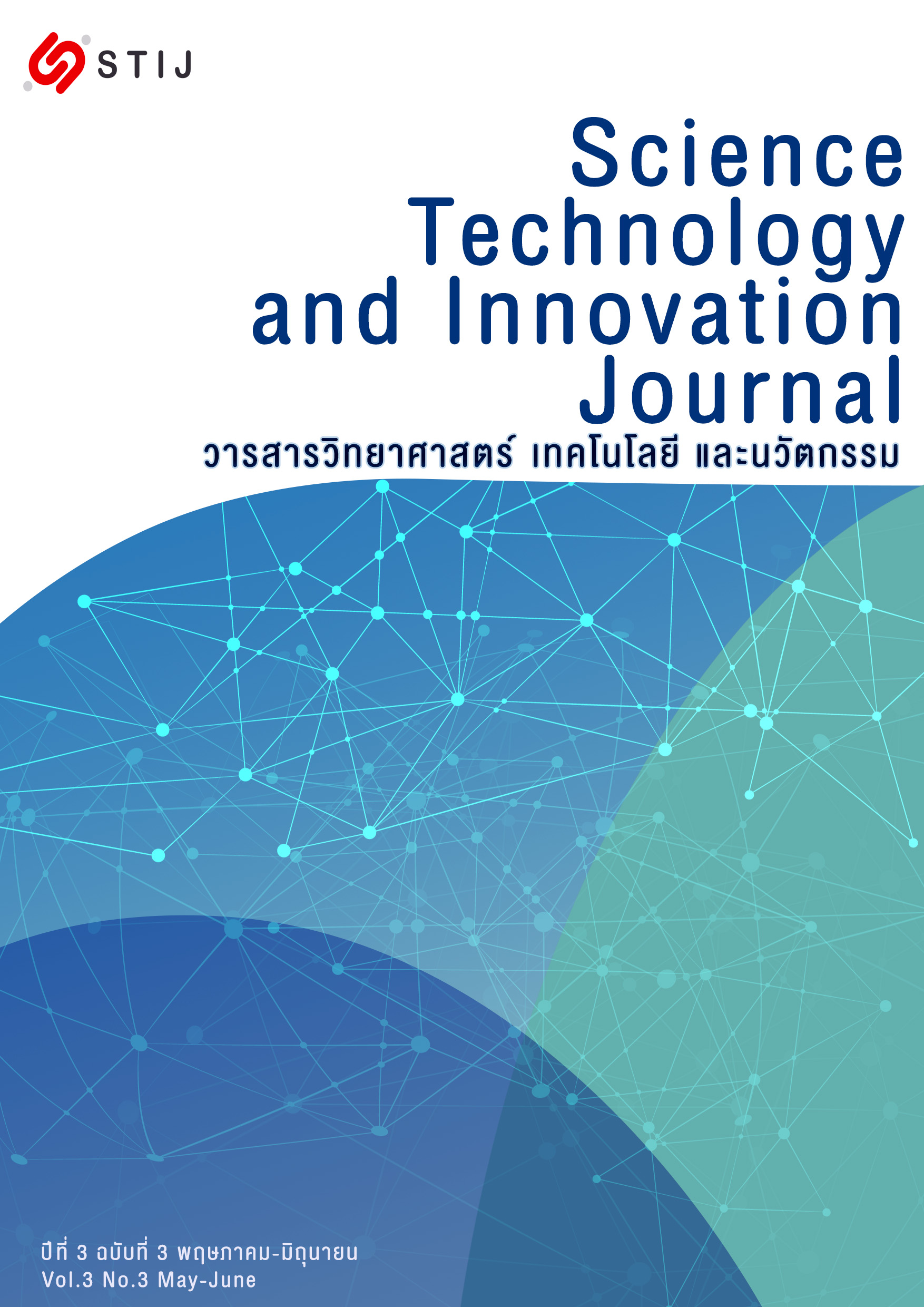การศึกษาประสิทธิภาพของปุ๋ยชีวภาพต่อการเร่งการเจริญเติบโตของผักคะน้า กวางตุ้ง และขึ้นฉ่าย ในการปลูกระบบอินทรีย์
คำสำคัญ:
เชื้อแบคทีเรียส่งเสริมการเจริญของพืช , การตรึงไนโตรเจน, การละลายละลายฟอสเฟต, การละลายโพแทสเซียมบทคัดย่อ
งานวิจัยนี้มีจุดประสงค์เพื่อทดสอบประสิทธิภาพของกลุ่มเชื้อแบคทีเรีย ที่มีคุณสมบัติบางประการในการส่งเสริมการเจริญเติบโตของพืช การเตรียมปุ๋ยชีวภาพโดยนำปุ๋ยอินทรีย์ที่เกษตรกรใช้ตามปกติมาผสมกับหัวเชื้อแบคทีเรีย จากนั้นนำปุ๋ยชีวภาพที่ได้ไปใช้ในการปลูกผักอินทรีย์ 3 ชนิด ได้แก่ คะน้า กวางตุ้ง และขึ้นฉ่าย โดยวางแผนการทดลองแบบสุ่มสมบูรณ์ ประกอบด้วย 4 กรรมวิธี คือ อัตราส่วนปุ๋ยอินทรีย์ต่อน้ำหมักแบคทีเรียที่ 1:0 1:0.5 1:1 และ 1:1.5 พบว่าปุ๋ยชีวภาพที่ได้ส่งผลต่อการเจริญเติบโตของผักทั้ง 3 ชนิด ในด้านความสูงของต้น ความยาวใบ ความกว้างใบ และน้ำหนักของต้น เมื่อพิจารณาที่น้ำหนักเฉลี่ยของผลผลิต พบว่าผลต่อน้ำหนักเฉลี่ยของคะน้าที่ปุ๋ยชีวภาพอัตราส่วน 1:1 ให้ค่าน้ำหนักของคะน้าเฉลี่ยสูงที่สุด 158.5 กรัม ขณะที่ปุ๋ยชีวภาพ อัตราส่วน 1:1.5 ให้ค่าน้ำหนักเฉลี่ยของกวางตุ้งเฉลี่ยสูงที่สุดเป็น 186.7 กรัม และน้ำหนักเฉลี่ยของขึ้นฉ่ายพบว่าปุ๋ยชีวภาพ อัตราส่วน 1:1.5 ให้ค่าน้ำหนักของขึ้นฉ่ายเฉลี่ยสูงที่สุด 24.8 กรัม ซึ่งมีค่าแตกต่างอย่างมีนัยสำคัญทางสถิติทางสถิติที่ความเชื่อมั่น 95 เปอร์เซ็นต์ เมื่อเทียบกับการใช้ปุ๋ยอินทรีย์ที่ไม่เติมเชื้อแบคทีเรีย จึงสามารถสรุปได้ว่าปุ๋ยชีวภาพที่ได้จากการใช้กลุ่มเชื้อแบคทีเรียดังกล่าวมีผลเร่งการเจริญเติบโตของพืช ซึ่งสามารถนำไปพัฒนาเป็นผลิตภัณฑ์สำหรับใช้ในการส่งเสริมการเจริญของพืชอย่างมีประสิทธิภาพต่อไป
เอกสารอ้างอิง
สำนักงานเกษตรจังหวัดราชบุรี. แผนพัฒนาจังหวัดราชบุรี พ.ศ.2561 – 2564 ฉบับทบทวน ปี พ.ศ. 2562). [อินเทอรเน็ต]. 2561 [เข้าถึงเมื่อ15 กันยายน 2562]; เข้าถึงได้จาก https://ratchaburi.industry.go.th/web-upload/migrated/files/2016_microsite_ratchaburi/319_cms_file_11615_article_file.pdf.
สำนักงานมาตรฐานสินค้าเกษตรและอาหารแห่งชาติ กระทรวงเกษตรและสหกรณ์. การตามสอบสินค้าเกษตรและอาหาร: หลักการและแนวทางสำหรับการออกแบบระบบการตามสอบและการนำไปปฏิบัติ. [อินเทอรเน็ต]. 2562 [เข้าถึงเมื่อ15 กันยายน 2562]; เข้าถึงได้จาก https://www.acfs.go.th/standard/download/TACPRINCIPLES%20AND%20GUDELINES%20FOR%20SYSTEM%20DESIGN%20AND%20IMPLEMENTATION.pdf. สืบค้น ณ วันที่ 15 กันยายน 2562
คณะกรรมการพัฒนาเกษตรอินทรีย์แห่งชาติ. ยุทธศาสตร์การพัฒนาเกษตรอินทรีย์แห่งชาติ (2560-2564). [อินเทอรเน็ต]. 2560 [เข้าถึงเมื่อ15 กันยายน 2562]; เข้าถึงได้จาก https://planning.dld.go.th/th/images/stories/section-5/2560/strategy11.pdf.
ณัฐวุฒิ เพชรนวล, ปฐมาภรณ์ ทิลารักษ์, พิริยาภรณ์ อันอาตม์งาม และ อมรรัตน์ สุวรรณโพธิ์ศรี. ปุ๋ยชีวภาพจากจุลินทรีย์โพรไบโอติกของพืช วารสารเกษตรศาสตร์และเทคโนโลยี. 2563.; 1(3): 11-21.
Inthasan, J., Dechjirarattanasiri, C. and Boonmee, P. Effect of Bacteria-producing Indole-3-Acetic Acid (IAA) on Growth and Nutrient Contents of Bird Chili (Capsicum annuum L.). Journal of Agriculture. 2017; 33(3): 333-344.
Naik, B.S., Shashikala, J. and Krishnamurthy, Y. Study on the diversity of endophytic communities from rice (Oryza sativa L.) and their antagonistic activities in vitro. Microbiol. Research. 164: 290-296.
Ahmad, F., Ahmad, I. and Khan, M.S. Screening of free-living rhizospheric bacteria for their multiple plant growth promoting activities. Microbiology Research. 2008; 163 : 173-181.
เสาวณีย์ ชูจิต. การคัดเลือกเชื้อแบคทีเรียจากแปลงปลูกผักอินทรีย์ที่มีคุณสมบัติตรึงไนโตรเจน ละลายฟอสเฟตและโพแทสเซียม และการสร้างฮอร์โมน. การประชุมวิชาการระดับชาติ ครั้งที่ 18 มหาวิทยาลัยเกษตรศาสตร์ วิทยาเขตกำแพงแสน วันที่ 8-9 ธันวาคม 2564. หน้า 54-62.
Kumar, A., Dana, V., Singh, M.K., Ratap, P.P., Kumar, S.S.D., Kumar, S.P., Kapil, S. and Pandey, D. Isolation of plant growth promoting rhizobacteria and their impact on growth and curcumin content in Curcuma longa L. Biocatalysis and Agricultural Biotechnology. 2016; 8: 1–7.
วราภรณ์ สุทธิสา และ บุษยา วาปี. การคัดแยกแบคทีเรียส่งเสริมการเจริญเติบโตของข้าวจากดินบริเวณรอบรากต้นบานไม่รู้โรยป่า (Gomphrena celosioides Mart.). วารสารวิทยาศาสตร์และเทคโนโลยี มหาวิทยาลัยอุบลราชธานี ปีที่ 21 ฉบับที่ 3 กันยายน – ธันวาคม 2562: 79-92.
ภัทธนาวรรณ์ ฉันท์รัตนโยธิน. การคัดแยกเชื้อจุลินทรีย์ที่มีประสิทธิภาพสูงในการสลายฟอสเฟตจากดินรอบรากของข้าวหอมมะลิแดง. รายงานวิจัยฉบับสมบูรณ์มหาวิทยาลัยแม่โจ้, เชียงใหม่. 2557. 55 หน้า.
Khan, A.A., Jilani, G., Akhtar, M.S., Naqvi, S.M.S. and Rasheed, M. Phosphorus solubilizing bacteria: occurrence, mechanisms and their role in crop production. Journal of Agriculture and Biological Sciences. 2009; 1(1): 48-58.
Raksaphol K. and Phornphisutthimas, S. Control of Fusarium wilt on tomato fruit by antagonistic yeasts isolated from natural sources. 20-21 October 2016. The 40th National Graduate Research Conference. Songkla, Thailand. 2016.
กมลชนก ห่วงมี, พิชญ์นันท์ กังแฮ, วันวิสาข์ ปั้นศักดิ์ และ วิภา หอมหวล. ความสามารถของแบคทีเรียละลายโพแทสเซียมต่อการงอกของเมล็ดข้าวพันธุ์พิษณุโลก 2 ในห้องปฏิบัติการ. วารสารดินและปุ๋ย ปีที่ 41 เล่มที่ 1 พ.ศ. 2562. 48-58.
Archana, D.S., Nandish, M.S., Savalagi, V.P. and Alagawadi, A.R. Characterization of potassium solubilizing bacteria (KSB) from rhizosphere soil. Bioinfolet. 2013; 10: 248-257.
Thakur, D., Kaur, M. and Mishra, A. Isolation and screening of plant growth promoting Bacillus spp. and Pseudomonas spp. and their effect on growth, rhizospheric population and phosphorous concentration of Aloe vera. Journal of Medicinal Plants Studies. 2017; 5(1): 187–192.
Tsavkelova, E., Oeser, B., Oren-Young, L., Israeli, M., Sasson, Y., Tudzynski, B., Sharon, A. Identification and functional characterization of indole-3-acetamide-mediated IAA biosynthesis in plant-associated Fusarium species. Fungal Genetics and Biology. 2012; 49: 48-57.
ไฟล์ประกอบ
เผยแพร่แล้ว
รูปแบบการอ้างอิง
ฉบับ
ประเภทบทความ
สัญญาอนุญาต
ลิขสิทธิ์ (c) 2022 วารสารวิทยาศาสตร์ เทคโนโลยี และนวัตกรรม

อนุญาตภายใต้เงื่อนไข Creative Commons Attribution-NonCommercial-NoDerivatives 4.0 International License.
1. บทความที่ลงตีพิมพ์ทุกเรื่องต้องผ่านการพิจารณาคุณภาพทางวิชาการจากผู้ทรงคุณวุฒิประจำศาสตร์ (Peer Review) จำนวน 3 ท่าน ต่อ 1 บทความ
2. ข้อความหรือข้อคิดเห็นในวารสารวิทยาศาสตร์ เทคโนโลยี และนวัตกรรม ฉบับนี้เป็นของผู้เขียนบทความ คณะผู้จัดวารสารไม่จำเป็นต้องเห็นด้วย
3. กองบรรณาธิการวารสารวิทยาศาสตร์ เทคโนโลยี และนวัตกรรม ไม่สงวนสิทธิ์ในการคัดลอกแต่ให้อ้างอิงแสดงที่มา


